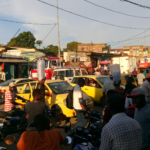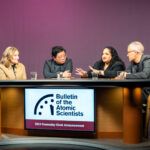Doomsday Clock remains at five minutes to midnight
By Bulletin Staff | January 14, 2013
The politics of economic recovery have distracted world leaders from the long-term threats that face humanity, specifically the dangers presented by climate change and nuclear weapons, observed the Science and Security Board of the Bulletin of the Atomic Scientists, as it announced today that the minute hand of its Doomsday Clock will remain at five minutes to midnight. “2012 was a year in which global problems pressed forward, but too many of its citizens stood back.”
The Bulletin of the Atomic Scientists: It is Now 5 Minutes to Midnight
CHICAGO — January 14, 2013 — The politics of economic recovery have distracted world leaders from the long-term threats that face humanity, specifically the dangers presented by climate change and nuclear weapons, observed the Science and Security Board of the Bulletin of the Atomic Scientists, as it announced today that the minute hand of its Doomsday Clock will remain at five minutes to midnight. "2012 was a year in which global problems pressed forward, but too many of its citizens stood back."
The last time the Doomsday Clock minute hand moved was in January 2012, when the Clock's hand was moved forward one minute, from six to five minutes before midnight.
In an unusual move, Board members directly addressed US President Barack Obama in an open letter published today by the Bulletin of the Atomic Scientists. In that letter they applaud the president’s recent actions to gain ratification of New START and to strengthen the nuclear security regime. They also acknowledge the steps the president took to "nudge the country along a more rational energy path," providing support for wind and other renewable energy sources and strengthening fuel-efficiency standards.
And yet, the letter continues, "2012 was the hottest year on record in the contiguous United States, marked by devastating drought and brutal storms. These extreme events are exactly what climate models predict for an atmosphere laden with greenhouse gases. 2012 was a year of unrealized opportunity to reduce nuclear stockpiles, to lower the immediacy of destruction from weapons on alert, and to control the spread of fissile materials and keep nuclear terrorism at bay. 2012 was a year in which — one year after the partial meltdown at the Fukushima Daiichi Nuclear Power Station — the Japanese nation continued to be at the earliest stages of what will be a costly and long recovery."
Robert Socolow, Chair of the Science and Security Board, noted, "We have as much hope for Obama’s second term in office as we did in 2010, when we moved back the hand of the Clock after his first year in office. This is the year for U.S. leadership in slowing climate change and setting a path toward a world without nuclear weapons."
"Among the recommendations for meeting the challenges," said board member Lynn Eden of Stanford University, "are to diminish the role of nuclear weapons by explicitly aiming to cut US deployed nuclear warheads to under 1,000."
Nuclear expert Alexander Glaser, of Princeton University, focused on the need "to stop all new production and eliminate existing stocks of separated fissile material, both civilian and military, worldwide. It is the ultimate protection against nuclear terrorism and supports nuclear disarmament."
Board member Richard Somerville, of Scripps Institution of Oceanography, University of California, San Diego, called on President Obama to make a priority of climate change in recognition of the gravity of the climate threat. He noted, "You have the ability to educate and inspire the United States to launch an ambitious response that will achieve progress on an energy strategy for the nation. You can introduce reforms to the patchwork of federal subsidies, taxes, and other incentives, to encourage reductions in US greenhouse gas emissions."
Recognizing that global warming is a worldwide challenge, the board encouraged President Obama to "partner with other world leaders to forge the comprehensive global response that the climate threat demands, based on equity and cooperation across countries. A global solution will only be within reach if the United States commits to doing its fair share, investing at home and globally to reduce climate change by curbing greenhouse gas emissions while building resilience in the face of the climate disruption that is now unavoidable."
HOW THE DOOMSDAY CLOCK DECISION WAS MADE
The January 14, 2013 Doomsday Clock decision followed an international symposium held November 29, 2012, at the American Association for the Advancement of Science, 100 New York Avenue NW, Washington, DC. The Science and Security Board of the Chicago-based Bulletin of the Atomic Scientists, in consultation with the Governing Board and the Board of Sponsors, which includes 18 Nobel Laureates, reviewed the implications of recent events and trends for the future of humanity with input from other experts on nuclear weapons, nuclear energy, climate change, and emerging threats. The Clock hand has been moved 20 times over the past 65 years, since its appearance in 1947 on the first cover of the Bulletin of the Atomic Scientists.
Click HERE for the Science and Security Board’s announcement and letter to President Obama.
Click HERE for the full program for the November 29th symposium.
ABOUT THE BULLETIN OF THE ATOMIC SCIENTISTS
Founded in 1945 by University of Chicago scientists who had helped develop the first atomic weapons in the Manhattan Project, the Bulletin of the Atomic Scientists subsequently created the Doomsday Clock in 1947 using the imagery of apocalypse (midnight) and the contemporary idiom of nuclear explosion (countdown to zero), to convey threats to humanity and the planet. The Clock has become a universally recognized indicator of the world's vulnerability to catastrophe from nuclear weapons, climate change, and emerging technologies in information and life sciences.
MEDIA CONTACT: Janice Sinclaire, 707.481.9372, or [email protected].
Together, we make the world safer.
The Bulletin elevates expert voices above the noise. But as an independent nonprofit organization, our operations depend on the support of readers like you. Help us continue to deliver quality journalism that holds leaders accountable. Your support of our work at any level is important. In return, we promise our coverage will be understandable, influential, vigilant, solution-oriented, and fair-minded. Together we can make a difference.














